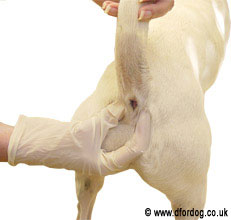
ANAL GLANDS IN DOGS

Every dog is unique. Some are star athletes, while others are couch potatoes. Some can fit inside a purse, while others can barely fit in the backseat of a car. Some are cute and cuddly, while others are noble and independent. Whether your dog is fast or slow, big or small, affectionate or aloof, there is one thing that all of our canine companions have in common: although it’s not a glorious activity from our human point of view, dogs love to sniff each other’s butts.
Of course it seems crude to us of the human variety, but in the dog world, sniffing another’s rear end is simply a social custom. Not unlike a handshake and introduction, or an exchange of business cards, dogs gain valuable information from sniffing around down there. Each dog has a unique scent that is produced by structures called anal glands (or anal sacs). While many owners aren’t even aware that these glands exist, they play an important role in a dog’s social behaviour; dogs use this scent to identify one another, as a form of communication, and as a way to mark their territory.
Anal glands are located just beneath the skin on either side of the anus (at positions 4 o’clock and 8 o’clock). They secrete a foul-smelling liquid which travels through small tubules to openings on either side of the anus. Believe it or not, every time your pet urinates or defecates, a tiny bit of this liquid is released as well, contributing to your dog’s personal fragrance. Similarly, when two dogs meet in the park, the action of raising their tails puts pressure on the anal glands, causing the butt sniffing to start in the first place.
The reason most owners are oblivious to the existence of anal glands, is because most of the time, they don’t cause any problems. For the majority of dogs, anal glands go about their business and express their liquid with each bowel movement and under appropriate social circumstances. However, in some cases, anal glands fail to empty sufficiently and can cause a number of issues for your pet.
The most common problem with anal glands occurs when lack of expression (emptying them) results in impaction. This is extremely uncomfortable for the dog who will usually let his owners know that there is a problem. Typical signs of anal gland impaction include scooting (dragging their rear ends along the ground) or licking/biting at their rear end. Some dogs will also present with loose stools. Fortunately, anal gland impaction can usually be cleared up quickly by your veterinarian. Veterinarians (as well as some breeders and groomers) are proficient at manually expressing anal glands to remove all of the secretion that has built up inside them. Often, one trip to the vet’s office will be enough to relieve your dog’s discomfort, however for other dogs anal gland impaction is an ongoing problem.
There are a variety of reasons why a dog might have trouble expressing its anal glands properly. Sometimes it is simply due to the conformation of the particular dog, or breed of dog. Other times it depends on the thickness of the secretion itself which may be too viscous to express easily. Also, the size and consistency of an animal’s stools can affect anal gland function. Stools which are too small or too soft might not put sufficient pressure on the glands to cause expression. For dogs who are suffering from chronic or recurring anal gland impaction, it is important to make sure they eat a high quality food which is high enough in fibre to ensure large solid stools. In some cases, it is recommended that a dog’s anal glands be surgically removed. This is a fairly simple procedure that can permanently solve the problem.
In addition to anal gland impaction (an uncomfortable, but fairly benign condition), some dogs will also suffer from infections and abscesses of the anal gland. This occurs when bacteria travels from around the anal opening through the tubules to the glands. When this bacteria builds up, serious infections can develop. If left untreated, abscesses can develop fairly quickly. In this case, dogs generally experience pain (as opposed to mere discomfort). Dogs will often present by biting or growling when one tries to touch them anywhere in the general area. Anal gland infections can be treated with antibiotics from your veterinarian. If the infection progresses to the abscess stage however, other complications may arise. It is therefore important to bring your dog to the vet as soon as you notice any signs that might indicate an anal gland problem.
For those dog owners who have never had to deal with an anal gland problem, consider yourselves lucky. As unpleasant as it may be to think about, your dog’s anal glands are as much as part of him as his cute little nose and his fluffy tail. Now that you know they exist, it is important to watch for any signs of anal gland problems in your pet.

0 comments:
Post a Comment